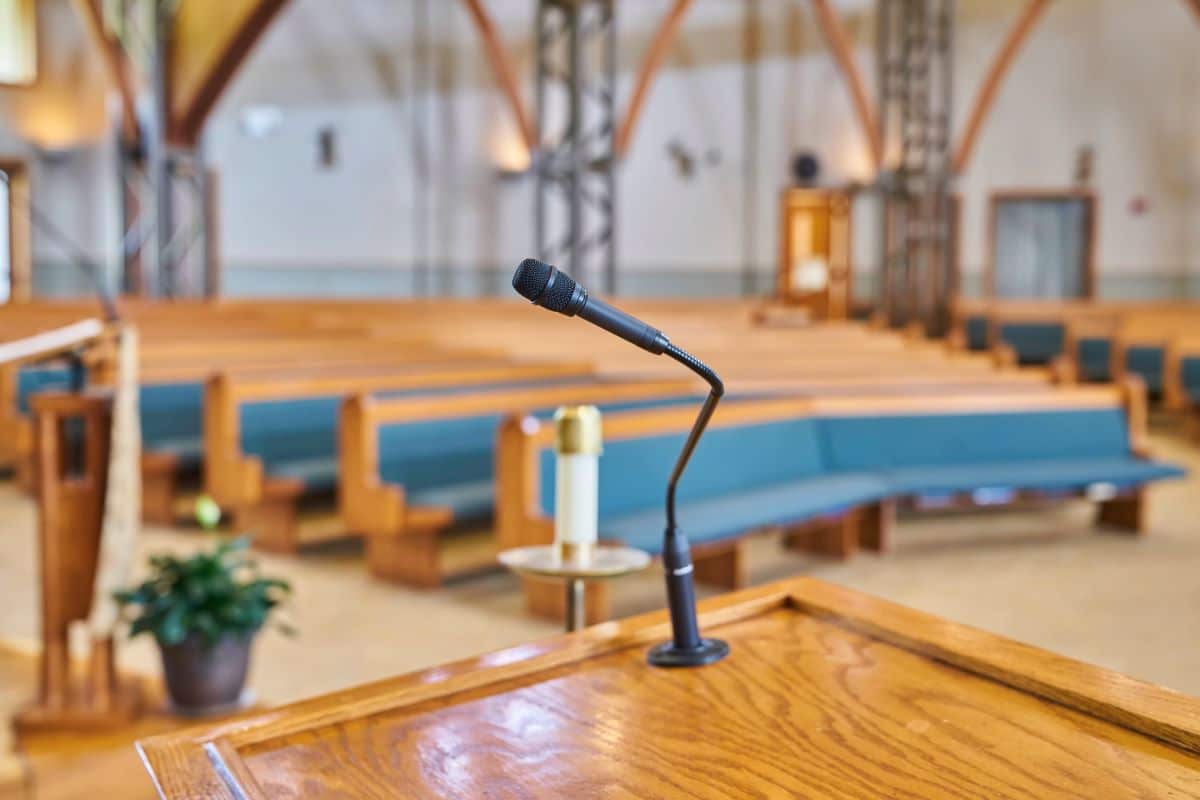With Christmas around the corner, churches nationwide are preparing their choirs and bands for special musical performances. But choirs and bands can be challenging for musical directors to deal with, considering many churches lack resources.
Some do not have all of the space they would like to have for adequate separation between singers and instruments. Some lack adequate microphones, stands and cables for each source, and have no alternate options. Audio quality can seem unpredictable, and congregations can struggle to deliver clear, pleasant sound from the microphones to the house speakers, stage monitors and in-ears, or video stream.
Are microphones causing your church issues, too? Microphones are an integral part of church audio visual systems, and if your church needs help this Christmas season, here’s our advice.
You need more microphones than you think.
If you have a small room with a loud choir, vocal group or band, you still need microphones. If you are capturing audio for video, living stream or recording, you need to capture all of the sources in the room to replicate the experience of being in the room. This may include some ambient microphones to capture the crowd’s response. We all have witnessed church YouTube videos with bad audio. People use YouTube to snoop on you, to see if they want to visit. This is your calling card to the world. Make it sound great.
Choose the best tool for the job.
If you are an average sized church, separation can be hard to achieve. It is important to select the correct mic with the best sensitivity and polar patterns for the mic’s source and location on stage. For instance, a singer standing in front of a drum kit would benefit from a dynamic mic designed to be used on loud stages. A pastor with monitors to the left and right of the pulpit will benefit from a microphone that is less sensitive on the side (Hyper-Cardioid). A singer in front of a stage monitor will benefit from a mic less sensitive on the back (Cardioid).
Mix the people to the microphones.
If you have hanging or stand mounted mics, mix your choir to the mics. Choir mics should follow the 3:1 rule. Let’s say the choir mics are 1 foot from the front row of the choir. They should be no less than 3 feet apart from one another. The closer the mics are, the more they will cancel one another.
Placement
Placing people in the choir loft based on symmetry or to make the choir loft look full doesn’t help the sound. Separate people by part. Place the loudest singers to the left and right of the mics. Place the others in front of the mics. This placement will yield a better blend. Your sound techs will be able to mix the parts better, and the group will sound like a choir instead of a few loud soloists with a group of lower-volume singers.
Listen on stage. If something sounds good on stage, mic it. If something doesn’t sound good on stage, change its location and microphone and location. Changing microphones and positions is better than reaching for a knob on the mixer. Direct mic’ing all instruments in a large orchestra may not be possible. Condenser microphones may be positioned between musicians or over the orchestra or conductor.
This is an art. You may need some help. In a good room, less can be more. If the room is not the best, imbed the mics in the orchestra. Walk the area. Sit in the seats. Use your ears. If it sounds good to you, it will be suitable for the mics.
Planning for Rentals
Holidays strain microphone rental inventories. You can rent wired and wireless microphones, cables, stands, and direct boxes (DIs). Sometimes, you can rent better mics than you could afford to purchase. If you don’t have an experienced sound tech, we recommend an on-site consultation to discuss your rental needs. This will take some of the guesswork out of it. Contact should be made now. Many rental suppliers are booked 90 days in advance.
Making Wireless Systems Work
Before you book a rental to add wireless microphones to your system, have a tech come to scan your airspace to determine the bands and frequencies you should be using. All wireless companies recommend using the same manufacturer and model to maximize the number of units and minimize interference. No two wireless systems work the same way or are guaranteed to play well with others.
Companies like Shure have Frequency Finder tools to help you see if you have the correct technology and quantity of wireless for your zip code. Since that app only works for their wireless solutions, you will need an experienced tech with a scanner, a computer with scanning software, etc.
There are industry standard tools and best practices that should be utilized if you are mixing multiple manufacturers and models of wireless systems, are in a central metropolitan area, are in a remote location with railroads or farms nearby, etc. The days of adding something without planning are over.
System Tuning
Your room is going to do what your room does to the sound. Your speakers and their locations will affect the sound. You are capturing the sound of your room with microphones and reproducing those reverbs, delays, and oddities in your room. Most times, speaker placement and room acoustics cannot be modified a few months before Christmas. Using digital signal processing (DSP) might be a quick-fix solution.
DSP can be used to ensure all of your speakers are reproducing sound in the seating area simultaneously with the sound coming from the stage. This is called time alignment. Time alignment in a large reverberant space can increase speech intelligibility. DSP tools in processors and digital mixers can turn off unused mics, filter out unwanted noises, shape vocals and instruments, and provide a consistent, pleasing output. This comes with experience.
If you need a skilled sound tech, you can go ahead and book the services of an experienced person to get the system and event performance dialed in and saved for future recall. Now is the time to get that help.
This article is courtesy of Advanced Sound & Communication, which provides the best in audio, video, lighting, control, security, and acoustic treatment solutions so the people in your spaces receive the messages you want to be delivered with an experience worth remembering, www.advancedsoundkc.com.













